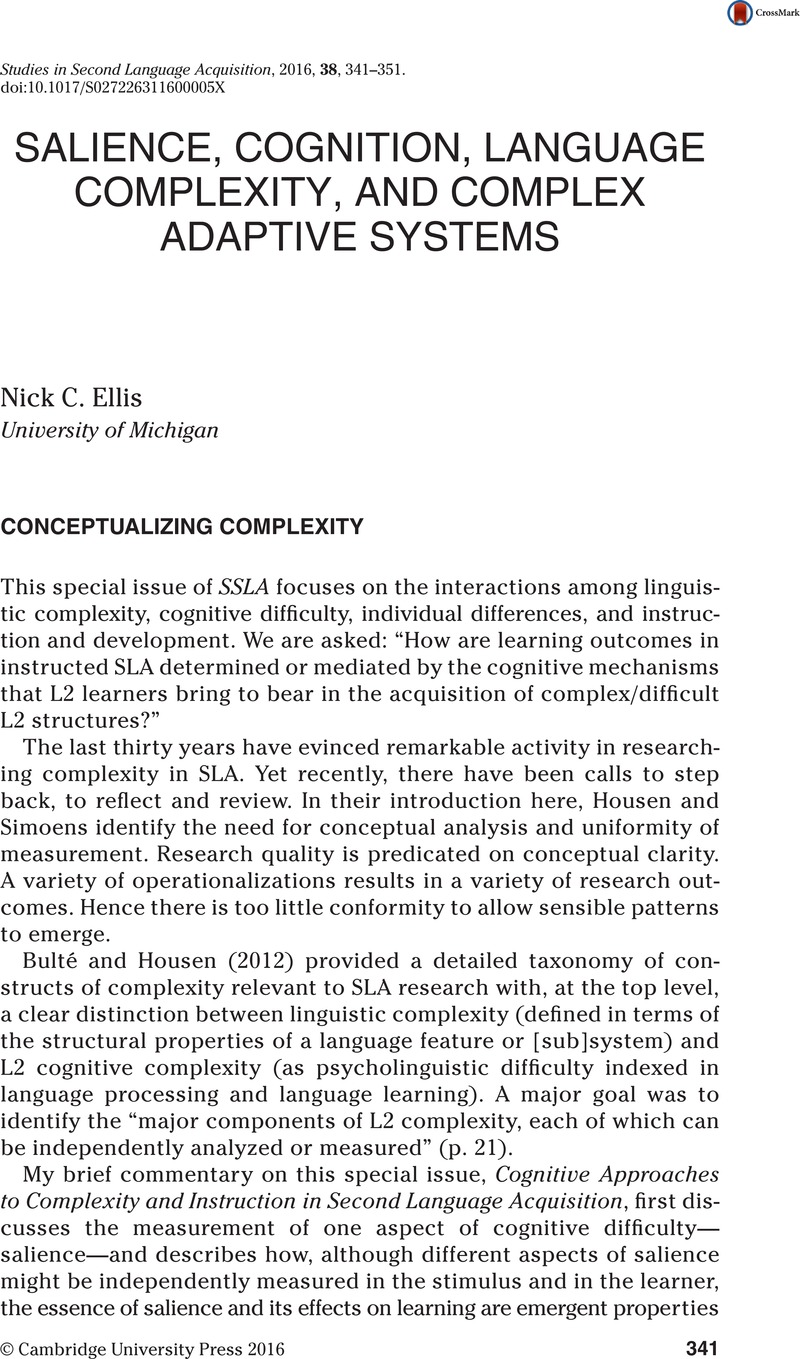Crossref Citations
This article has been cited by the following publications. This list is generated based on data provided by Crossref.
Cerezo, Luis
Caras, Allison
and
Leow, Ronald P.
2016.
THE EFFECTIVENESS OF GUIDED INDUCTION VERSUS DEDUCTIVE INSTRUCTION ON THE DEVELOPMENT OF COMPLEX SPANISHGUSTARSTRUCTURES.
Studies in Second Language Acquisition,
Vol. 38,
Issue. 2,
p.
265.
Housen, Alex
and
Simoens, Hannelore
2016.
INTRODUCTION: COGNITIVE PERSPECTIVES ON DIFFICULTY AND COMPLEXITY IN L2 ACQUISITION.
Studies in Second Language Acquisition,
Vol. 38,
Issue. 2,
p.
163.
Schmid, Monika S.
and
Köpke, Barbara
2017.
The relevance of first language attrition to theories of bilingual development.
Linguistic Approaches to Bilingualism,
Vol. 7,
Issue. 6,
p.
637.
Nyqvist, Eeva-Liisa
2018.
Mastering complex Swedish NPs: A comparison of non-immersion pupils and
immersion L1 Finnish pupils.
Journal of the European Second Language Association,
Vol. 2,
Issue. 1,
p.
14.
Mellinger, Christopher D.
2018.
Re-thinking translation quality.
Target. International Journal of Translation Studies,
p.
310.
Byrnes, Heidi
2018.
The Handbook of Advanced Proficiency in Second Language Acquisition.
p.
131.
Nyqvist, Eeva-Liisa
2018.
Definiteness in written Swedish by Finnish-speaking immersion pupils
at the end of immersion.
Journal of Immersion and Content-Based Language Education,
Vol. 6,
Issue. 1,
p.
57.
Ishikawa, Keiichi
2019.
Incidental and explicit learning of L2 derivational morphology and the nature of acquired knowledge.
Applied Psycholinguistics,
Vol. 40,
Issue. 6,
p.
1377.
Nassif, Lama
2019.
Salience in the noticing and production of L2 arabic forms.
Foreign Language Annals,
Vol. 52,
Issue. 2,
p.
433.
Jiang, Jingyang
Yu, Wuzhe
and
Liu, Haitao
2019.
Does Scale-Free Syntactic Network Emerge in Second Language Learning?.
Frontiers in Psychology,
Vol. 10,
Issue. ,
2019.
Learning Differentiated Curriculum Design in Higher Education.
p.
203.
Hsieh, Yufen
2020.
Effects of video captioning on EFL vocabulary learning and listening comprehension.
Computer Assisted Language Learning,
Vol. 33,
Issue. 5-6,
p.
567.
Kamiya, Masaaki
and
Ananth, Priya
2020.
Learnability issues in L2 Japanese: Prosody and ambiguity resolution
.
Journal of Japanese Linguistics,
Vol. 36,
Issue. 1,
p.
3.
Boswijk, Vincent
Loerts, Hanneke
and
Hilton, Nanna Haug
2020.
Salience is in the eye of the beholder: Increased pupil size reflects acoustically salient variables.
Ampersand,
Vol. 7,
Issue. ,
p.
100061.
Azar, Zeynep
Özyürek, Aslı
and
Backus, Ad
2020.
Turkish-Dutch bilinguals maintain language-specific reference tracking strategies in elicited narratives.
International Journal of Bilingualism,
Vol. 24,
Issue. 2,
p.
376.
2021.
The Psychophysics of Learning.
p.
133.
Nyqvist, Eeva-Liisa
and
Lahtinen, Sinikka
2021.
Grammatical gender in L2 Swedish in Finnish-speaking immersion students: A comparison with non-immersion students.
Nordic Journal of Linguistics,
Vol. 44,
Issue. 3,
p.
281.
Nyqvist, Eeva-Liisa
and
Tiedemann, Therese Lindström
2021.
Finska språkbadselevers bruk av svensk passiv.
Nordand,
Vol. 16,
Issue. 1,
p.
36.
Davydova, Julia
2021.
The role of sociocognitive salience in the acquisition of structured variation and linguistic diffusion: Evidence from quotativebe like.
Language in Society,
Vol. 50,
Issue. 2,
p.
171.
Kim, Young Kwang
2022.
How to Enhance Language Awareness of Beginners Using the American TV Comedy Brooklyn Nine-Nine.
STEM Journal,
Vol. 23,
Issue. 2,
p.
1.





